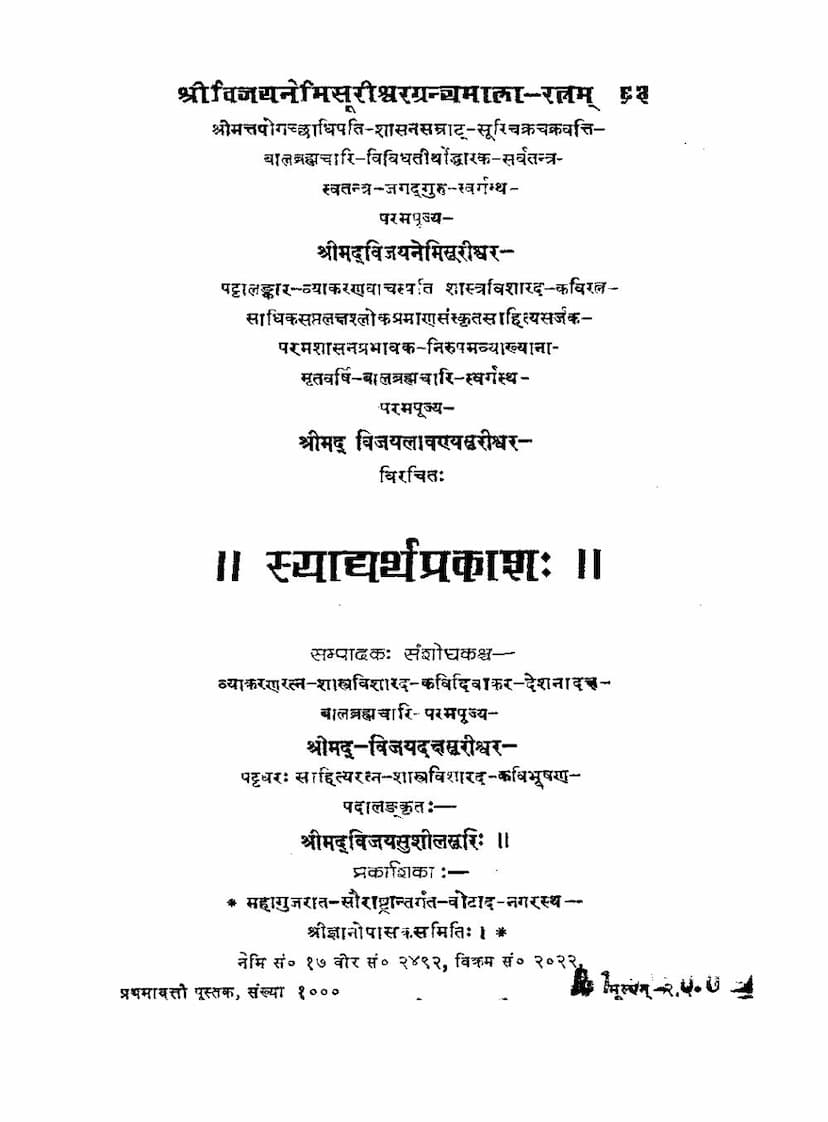Syadyarthaprakash
Added to library: September 2, 2025

Summary
This is a summary of the Jain text "Syadyarthaprakash" (स्याद्यर्थप्रकाश) by Acharya Shrimad Vijaya Lavanyasurishwarji, edited and compiled by Acharya Shrimad Vijaya Sushilsuriji.
Title: Syadyarthaprakash (स्याद्यर्थप्रकाश) - "Illumination of the Syadartha"
Author: Acharya Shrimad Vijaya Lavanyasurishwarji Maharajshri
Editor/Compiler: Acharya Shrimad Vijaya Sushilsuriji
Publisher: Shri Gyana-upasak Samiti, Botad, Saurashtra.
Subject Matter: The book primarily deals with Jain logic and grammar, specifically focusing on the Syadvada doctrine (the doctrine of conditional predication) and its application in understanding grammatical cases and their meanings. It is a profound commentary on the nuances of Jain philosophy as expressed through the lens of grammar.
Key Themes and Content:
-
The Syadvada Doctrine: The title itself, "Syadyarthaprakash," indicates a focus on the Syadvada doctrine. Syadvada, a cornerstone of Jain logic, asserts that all statements are conditional and have multiple facets of truth, depending on the perspective. The book aims to illuminate the "Syadartha" – the meaning conveyed through the lens of Syadvada. This involves understanding how different aspects of reality can be expressed and how seemingly contradictory statements can be reconciled through this doctrine.
-
Grammatical Analysis of Cases (Vibhakti): A significant portion of the book is dedicated to a detailed grammatical analysis of the different Vibhakti (cases) in Sanskrit grammar. The author meticulously examines the meaning and function of each case (Prathama, Dvitiya, Tritiya, Chaturthi, Panchami, Shashti, Saptami) in relation to the Syadvada philosophy.
- Karaka and Vibhakti: The text delves into the concept of 'Karaka' (the agent or instrument performing an action) and its relationship with 'Vibhakti' (case endings). It explains how various case endings convey different meanings and roles within a sentence, always interpreted through the framework of Syadvada.
- Detailed Examination of Each Case: The book systematically breaks down each case, exploring its various meanings, exceptions, and applications.
- Prathama (Nominative Case): Discusses its role, often associated with the subject or the primary actor.
- Dvitiya (Accusative Case): Explores its connection to the object of the action, focusing on concepts like 'what is sought' (ipsita) and 'what is acted upon'.
- Tritiya (Instrumental Case): Examines its function in indicating the instrument, means, or agent, often linked to 'how' or 'by what' an action is performed.
- Chaturthi (Dative Case): Discusses its association with the recipient, purpose, or cause for which an action is done.
- Panchami (Ablative Case): Analyzes its meaning of separation, origin, or cause from which something moves or is distinct.
- Shashti (Genitive Case): Explores its role in indicating possession, relationship, or belonging.
- Saptami (Locative Case): Delves into its meaning of location, time, or basis of an action.
- Interrelation of Cases and Syadvada: The central argument is how the Syadvada perspective clarifies the manifold meanings of each case, resolving apparent contradictions and demonstrating the completeness of Jain logic.
-
Philosophical Integration: Beyond pure grammar, the book integrates Jain philosophical concepts. The Syadvada lens is applied to understand:
- The Nature of Reality: How grammatical nuances, interpreted through Syadvada, reflect the multifaceted nature of reality.
- Anekanta (Multiplicity of Aspects): The core Jain principle of Anekanta is shown through the various meanings and contexts of grammatical elements.
- The Role of Intention (Vivaksha): The text likely emphasizes how the speaker's intention (Vivaksha) plays a crucial role in determining the appropriate case and meaning.
-
Scholarly Approach: The author, Acharya Lavanyasurishwarji, is presented as a highly learned scholar, a grammarian, and a master of various sciences. The book reflects this, offering deep analysis, referencing traditional grammatical rules, and providing explanations for complex philosophical points. The editorial work by Acharya Sushilsuriji ensures a polished and accurate presentation.
-
Purpose and Audience: The book aims to elucidate the profound meaning of Syadvada, particularly as it relates to Sanskrit grammar, for scholars, students of Jain philosophy, and those interested in linguistics and logic from a Jain perspective. The publication is intended to spread the knowledge of Jain teachings through the study of its philosophical underpinnings in language.
In essence, Syadyarthaprakash is a sophisticated work of Jain scholarship that uses the intricate rules of Sanskrit grammar as a vehicle to explore and expound the fundamental Jain philosophical principle of Syadvada. It demonstrates how this doctrine provides a comprehensive framework for understanding language, reality, and the nature of truth.